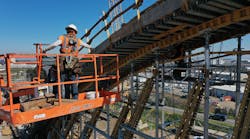Caltrain completes installation of poles for Overhead Contact System
Caltrain has completed the installation of every pole for the Overhead Contact System (OCS), which provides power to the electric trains, upgraded the signal system that allow electric trains to operate along the Caltrain corridor and successfully tested the new electric trains at maximum track speed of 79 mph. These three major milestones bring the Caltrain Electrification Project closer to passenger service in fall 2024.
Caltrain and contractor Balfour Beatty have worked to install 2,569 pre-engineered poles and upgraded the existing signal system that will allow the electric trains to operate in an electrified corridor along the nearly 160-year-old right-of-way, which has continued to be an active railroad during the process. The work in upgrading the existing signal system included upgrading every grade crossing on the electrified corridor. The steel poles were safely lifted and elevated into place and then mounted on concrete foundation, a process that involved ongoing collaboration and hours of work around the clock to complete.
With the final OCS pole installed, crews can now hang the last of the wire, as well as finish the final work on the OCS that will provide power to the electric trains, which will be tested along the full corridor from San Francisco to San Jose later this year.
Additionally, Caltrain and the vehicle manufacturer, Stadler, have successfully run tests using the OCS and the upgraded signal system with the new electric trains operating at maximum track speed to ensure all the individual systems are working together as intended. Cameras were placed atop the trains to ensure the interface between the pantograph on the train and the OCS was fully integrated and operating as designed and constructed. The trains were first tested at walking speed. With each subsequent test, the speed was increased until reaching the maximum authorized track speed of 79 miles per hour.
“These three milestones are a big step forward for the Caltrain Electrification Project and we’re now even closer to completing this transformative project,” said Caltrain’s Executive Director Michelle Bouchard. “I’m grateful to the tireless work of our staff and partners who have gotten us to this point.”
The South San Francisco Traction Power Facility went live in August, making it possible to fully power the entire Caltrain electrified corridor once the testing and OCS is complete this fall. Trains are currently being tested on the southern end of the corridor and will be expanding to more parts of the system in the months to come. The 51-mile Caltrain Electrification Project will be the first 25KV OCS system on the west coast and will provide power to the new state-of-the-art-electric trains.
As crews continue to install more poles and wire for the electrification system, Caltrain is embarking on a public outreach campaign to educate passengers, residents and businesses about best safety practices along the corridor. The agency has sent out mailers, hosted community meetings and embarked on social media campaigns to remind everyone all overhead wires on Caltrain property should be assumed to be energized now.
The electrification of the Caltrain system will deliver major benefits to the communities that it serves. Electrification will reduce Caltrain’s greenhouse gas emissions and eliminate the particulate matter caused by the aging diesel engines. Engine noise created by the trains will also be reduced.
Service will become both more frequent and more comfortable, as state-of-the-art electric trains replace the 30-year-old diesel fleet. Caltrain electrification has also created thousands of jobs locally and throughout the country, both to electrify the corridor and to assemble the new trains. The infrastructure that is being installed will be compatible with future high-speed rail on the corridor.




